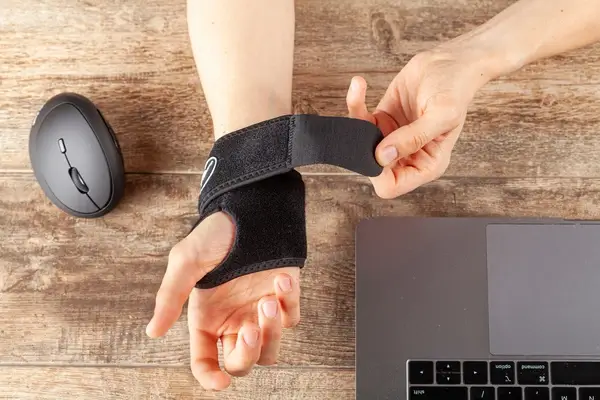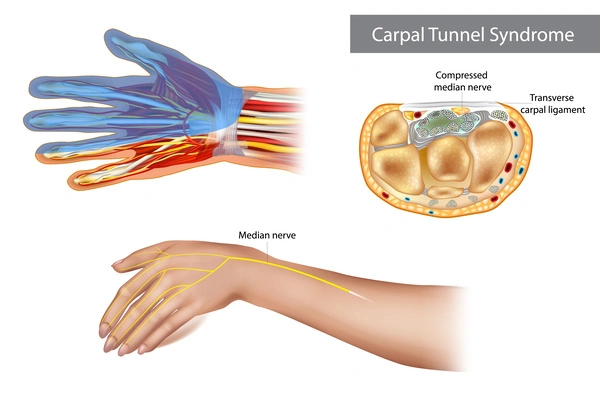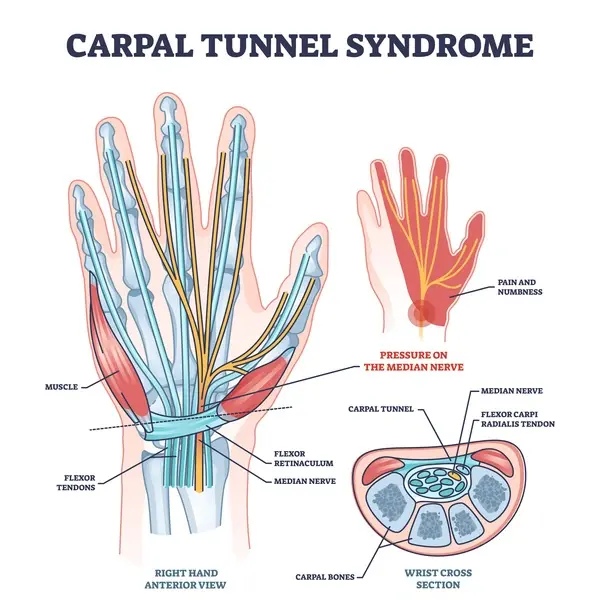Estimated reading time: 6 minutes
If you’re experiencing the pain, numbness, and tingling symptoms of carpal tunnel, surgery can help. And preparing for the procedure is just as important as the surgery itself.
Our carpal tunnel surgery recovery guide provides all the essential information and tips you need to make a full recovery.

Private carpal tunnel surgery at a glance
- Waiting time: 4-6 weeks
- Cost: £2,249
- Ways to pay: self-pay, insured, payment plans
On this page:
Carpal tunnel surgery relieves pressure on the median nerve. Full recovery typically takes between 3–4 months with hand strength returning within a year. Post-operative care, gentle exercises, and avoiding heavy lifting are key to restoring mobility and preventing complications.
Carpal tunnel surgery explained
Along with the cost of carpal tunnel surgery, you may also be exploring the ins and outs of the procedure itself. During this type of surgery, the carpal ligament (the roof of the carpal tunnel) is cut. This is to relieve pressure on the median nerve in the wrist. In most cases, surgery can solve the symptoms of carpal tunnel syndrome.
Carpal tunnel surgery recovery time
Although the recovery time for carpal tunnel surgery can vary from person-to-person, it generally takes between three to four months to fully recover and up to a year for hand strength to fully return.
The recovery process will vary from patient-to-patient. The type of carpal tunnel surgery you had (open surgery or endoscopic surgery), the severity of your condition, and your overall health are also contributing factors.
Did you know?
Carpal tunnel affects roughly 1 in 20 people in the UK and the condition is more common in women than men1.
Carpal tunnel surgery recovery timeline
Here’s a step-by-step guide breakdown of what patients can expect during their recovery process.
Immediate recuperation from carpal tunnel surgery – the first few days
After your carpal tunnel surgery, the area will be bandaged for 24-48 hours. You should keep your hand elevated to reduce swelling. You may experience some pain, discomfort, swelling, or limited mobility in your hand and wrist.
You will usually be asked to wear a shoulder sling but will typically be encouraged to move your fingers and use the hand as normal as soon as possible. This is to help promote mobility and reduce stiffness and swelling. This will likely begin on the day of your operation. Avoid bearing weight through the hand and gripping as these can cause pain.
First two weeks
In the first 14 days post-surgery, follow your surgeon’s instructions regarding wound care, pain medication and hand elevation. Keep the surgical site clean and dry to prevent infection.
You can continue to perform finger and hand exercises as recommended by your surgeon or physiotherapist. However, avoid heavy lifting and bearing weight through the hand as your strength returns.
Remember to attend the first follow-up appointment to have any stitches or sutures removed.
Two-to-six weeks
Swelling and discomfort should start to decrease gradually at this stage. You should continue to use your wrist and hand as normal to encourage wrist strength and mobility. Continue with hand exercises a few times a day and any rehabilitation programs recommended by your healthcare provider.
Depending on the nature of your job, you should be able to return to work after four weeks if your job is not manual. However, you should seek your doctor’s advice before doing so.
Six-to-twelve weeks
Patients with manual jobs should be able to return to work following the advice of their surgeon.
Swelling should continue to decrease and the surgical incision should be healing well. Hand and wrist strength, along with general arm mobility should improve further.
Regular follow-up appointments will be scheduled to monitor your progress. It is important to attend these to give yourself the best chance of a full recovery.
Three-to-six months
By this time, most people will see a significant improvement in their hand function and symptom relief. You should be able to resume full activities without restrictions.
It’s important to continue practising good hand and wrist care to prevent the recurrence of carpal tunnel syndrome.

Carpal tunnel surgery recovery and time off work
The duration of your recovery and when you can return to work will depend on the nature of your job. Discuss with your surgeon when it is safe to resume work activities.
Carpal tunnel surgery recovery and driving
You should refrain from driving until you regain full control and strength in your hand. Check with your surgeon before getting behind the wheel.

Carpal tunnel release recovery tips
The following tips can help ensure a full and fast recovery:
- Follow your surgeon’s instructions regarding wound care. Keep the surgical site clean and dry to prevent infection. Use any prescribed medicines or dressings as directed
- Take the prescribed pain medication as directed by your surgeon to help manage carpal tunnel pain effectively. If you have any concerns, consult your healthcare provider
- Elevate your hand above heart level to reduce swelling and promote blood circulation. Use pillows or cushions to prop up your hand while resting or sleeping
- Avoid heavy lifting and strong gripping in the initial weeks after surgery. Gradually resume normal activities based on your surgeon’s advice
- While you should use your affected hand as normal, as always, rest plays a key role in recovery
- Your surgeon may provide you with a wrist splint or compression garment to wear during the initial stages of recovery. Follow their recommendations on when and how to wear them
- Attend all scheduled follow-up appointments. These visits are crucial to monitor your progress. They will also be used to remove any stitches and assess the general healing process
- Eat a healthy, balanced, and nutritious diet to encourage healing.
Carpal tunnel recovery exercises
Your surgeon or a physiotherapist may recommend gentle exercises to improve hand mobility and strengthen the muscles. Performing these carpal tunnel exercises regularly can help speed up your recovery.
Carpal tunnel surgery – at a glance
Complications when recovering from carpal tunnel release surgery
It’s important to contact your healthcare provider if you notice any of the following symptoms post-surgery:
- signs of infection. This may show through increased redness, warmth, swelling or discharge from the surgical site
- continuous bleeding or excessive blood soaking through the dressings
- developing a rash, itching, hives or difficulty breathing may be a sign of an allergic reaction to medications or dressings
- severe pain, loss of sensation or difficulty moving your wrist or fingers
- symptoms failing to improve or worsening after a reasonable period.
Carpal tunnel surgery is a common procedure to alleviate the symptoms of carpal tunnel syndrome. Following this recovery guide, along with your surgeon’s instructions, will help to ensure a successful recovery. Remember to be patient and give yourself time to heal.
Contact your healthcare provider if you have any concerns or questions during your recovery journey. With proper care, you can regain function in your hand and get back to the activities you love.
Carpal tunnel operation recovery FAQs
Not yet found the information you’re looking for? Our carpal tunnel recovery FAQs can help!
In some cases, carpal tunnel syndrome can be managed without surgery. Non-surgical options include:
– the use of wrist splints
– medications
– corticosteroid injections
– occupational therapy
– lifestyle modifications
– hand and wrist exercises.
In some cases, these treatments can help alleviate symptoms and improve hand function.
It is recommended to start using your affected hand as normal as soon as possible after surgery. Avoid strenuous lifting and strong gripping in the first few weeks as these can cause pain.
After carpal tunnel surgery, it is important to give your hand and wrist adequate rest. This will allow for proper healing. The duration of rest needed may vary from person-to-person. Follow your surgeon’s recommendations and be sure to listen to your body.
The average recovery time for carpal tunnel surgery varies from person-to-person. It generally takes between three to six months to fully recover.
To encourage a fast recovery, follow the advice of your health provider. The tips in this guide will also help to ensure a full and speedy recovery.
After carpal tunnel surgery, you should avoid the following activities:
– excessive use of the operated hand, especially heavy lifting and strong gripping
– removing dressings or bandages prematurely without your surgeon’s guidance
– exposing the surgical site to excessive moisture or soaking in water until cleared by your surgeon
– applying heat or cold therapy directly to the surgical area without medical approval
– ignoring signs of infection. These include redness, swelling, or discharge. You should contact your healthcare provider immediately if you suspect an infection.
Temporary restrictions – yes. Permanent – no. If all goes well with your recovery, you should be able to enjoy your usual activities in the weeks and months following your surgery.
Yes. You can typically wiggle your fingers after carpal tunnel surgery. In fact, finger movements and exercises are often encouraged as part of the post-operative recovery process. However, it’s essential to follow your surgeon’s specific instructions regarding hand movements and exercises.
Yes, you can typically bend your wrist after carpal tunnel surgery. However, the extent and timing of wrist bending may vary based on your surgeon’s instructions and your individual healing progress. In the immediate post-operative phase, your hand and wrist may be immobilised with a splint or bandage to support the healing process.
Lifting something heavy too soon after carpal tunnel surgery can potentially have negative consequences on your recovery and the healing process. It could lead to increased pain and discomfort, delayed wound healing, damage to surgical repair and strain.
Elevate your hand and wrist above heart level using pillows or cushions. This will help to reduce swelling. Wear the splint or brace provided by your surgeon. This will provide support and protection to the affected wrist.
Additional pillows can also support your arm and help maintain a comfortable position. Consider sleeping on your back or in a position that avoids putting pressure on the operated hand.
Use a waterproof cover or bag to protect the operated hand and wrist from water. Use the non-operated hand to wash yourself. Avoid direct contact of the surgical area with water or soap and gently pat the surgical site dry after showering.
It’s normal to experience some degree of swelling in the early stages of recovery and varies from person-to-person. This swelling typically subsides over time. Swelling usually resolves within a few weeks to a couple of months after surgery.
You should be able to drive again around two weeks after surgery. This does vary from person-to-person as everyone heals at different speeds.
As with the recovery from any surgery, being sensible can go a long way. For example, you should avoid lifting heavy objects and partaking in activities that put your affected hand at risk of impact. Repetitive hand and arm movements should also be avoided.
Discomfort after surgery is pretty normal. You may even experience some numbness and general weakness in the affect hand and wrist. These after effects can be managed by pain medications prescribed by your consultant.
Yes, it’s a good idea to do so. This is because wrapping keeps your wrist straight and supported. It can also help to reduce inflammation and protect against other potential hand injuries during your recovery. Try to avoid getting the wrapping wet and be sure to change the bandaging every few days.
As everyone is different, it isn’t so much a case of ‘must-haves’, but more playing it by ear. For example, if you aren’t experiencing any discomfort, you may not need pain medication. Keeping your hand and wrist wrapped is a good idea as it helps to keep your wrist straight, supported, and protected from other potential injuries. Regular icing will help manage any inflammation, while rest can also play a significant role in recovery.
Sources and references
1 National Library of Medicine







